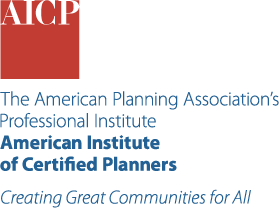Looking for education on this topic?
Check Out Our Passport Courses
Passport is your ticket to the training, experiences, and connections that will take you where you want to go in your planning career. Subscribe for unlimited access for one year to APA's extensive learning library of solution-oriented content facilitated by planners, for planners.
-
History of Racist Planning in Portland
September 2019by: City of Portland Bureau of Planning and SustainabilityThis report summarizes and reflects on the city of Portland's use of racist and exclusionary planning practices, as a way of actively addressing and preventing further harm to affected communities. -
A Call to Courage: An Open Letter to Canadian Urbanists
June 2020by: Jay PitterThis article and online training encourages urbanists working in the Canadian context to respond to discussions of systemic oppression and anti-Black racism occurring across North America. -
Working With Differences in Communities
Oregon State University Extension Service, Manual 13: March 2002by: Ann SchauberThis book explores intercultural communication and provides strategies for working with cultural difference. -
What Does "Equity" Look Like? A Synthesis of Equity Policy, Administration and Planning in the Portland, Oregon, Metropolitan Area
April 2014by: Diane BesserThis report shares the results from a literature review and series of interviews with regional equity experts which explores the opportunities and challenges of achieving social equity in Portland, Oregon. -
America’s Tomorrow: Equity is the Superior Growth Model
2011by: Angela Glover Blackwell, Manuel PastorThis report lays out a framework for equity-driven growth that is responsive to economic and demographic changes. -
The Ingredients of Equitable Development Planning: A Cross-Case Analysis of Equitable Development Planning and CDFIs
2019by: Alexander Von HoffmanThis report introduces the practice of equitable development and shares three case studies from Washington DC, Detroit, and Phoenix. -
Equitable Development and Urban Park Space: Results and Insights from the First Two Years of Implementation of the Equitable Development Plan of DC’s 11th Street Bridge Park Project
March 2019by: Mary Bogle, Somala Diby, Mychal CohenThis report assesses whether the ongoing Bridge Park project in Washington DC has been a driver of inclusive growth. -
Municipal Innovations in Immigrant Integration: 20 Cities, 20 Good Practices
September 2010by: Ricardo Gambetta, Zivile GedrimaiteThis report shares what local governments are doing to address immigration in the absence of a national immigrant integration policy. -
America's Racially Diverse Suburbs: Opportunities and Challenges
July 2012by: Myron Orfield, Thomas LuceThis report studies the largest 50 metropolitan areas in the U.S. to create a typology of the racial diversity of suburbs. -
The Business Case for Racial Equity
2018by: Ani TurnerThe report details the economic impact of racial inequity and the benefits of advancing racial equity as a strategy for economic growth. -
Community Immersion, Trust-Building, and Recruitment Among Hard to Reach Populations: A Case Study of Muslim Women in Detroit Metro Area
Qualitative Sociology Review, 14(3): 24-44, 2018by: Mehri Mohebbi, Annulla Linders, Carla Chifos, AICPThis article shows that trust is a necessary component for doing research with hard-to-reach populations. -
Equity Planning Outside City Hall: Rescaling Advocacy to Confront the Sources of Urban Problems
Journal of Planning Education and Research, 35(3): 296-306, 2015by: Marc DoussardThis article reviews how and when equity planners should partner with outside organizations to push for large-scale redistributive policies. -
“We're Not in the Business of Housing:" Environmental Gentrification and the Nonprofitization of Green Infrastructure Projects
Cities, 81(2018): 71-80, 2018by: Alessandro Rigolon, Jeremy NemethThis article looks at the procedural justice issues of large green infrastructure projects. -
Dietary Inequalities: What is the Evidence for the Effect of the Neighbourhood Food Environment?
Health Place, 27: 229-242, 2014by: Christina Black, Graham Moon, Janis BairdThis article outlines the state of research concerning food environments and dietary intake. -
6 Ways Cities Can Create Economic Opportunity for All
Governing, July 2018by: Sterling JohnsonThis article argues that cities need to revise their planning processes in order to achieve more equity, rather than looking for policy solutions. -
A Divided Neighborhood Comes Together Under an Elevated Expressway
Next City, August 2018by: Katy ReckdahlThis article tracks a group of New Orleans residents that are reclaiming a space stripped from their community decades ago. -
Creating Welcoming and Inclusive Communities
Minnesota Cities Magazine, May-Jun 2018by: Danielle CabotThis article features a city’s response to a hate crime and their efforts to create a more inclusive community. -
Active Living and Social Justice: Planning for Physical Activity in Low-income, Black, and Latino Communities
Journal of the American Planning Association, 72(1): 88-99, 2006by: Kristen DayThis article belongs to the Built Environment and Health and Social Equity collections. -
Do Strict Land Use Regulations Make Metropolitan Areas More Segregated by Income?
Journal of the American Planning Association, 82(1): 6-21, 2016by: Michael Lens, Paavo MonkkonenThis article finds that density restrictions are related to the segregation of the rich into enclaves and suggests that inclusionary housing requirements from regional and state agencies may help curb income segregation. -
Refusing to Appropriate: The Emerging Discourse on Planning and Race
Journal of the American Planning Association, 60(2): 242-243, 1994by: Teresa CordovaThis article unapologetically claims that race cannot continue to be a taboo subject in planning and urges planners to create a more equitable planning process. -
Evaluating Transportation Equity
World Transport Policy & Practice, 8(2): 50-65, 2002by: Todd LitmanThis article introduces transport equity analysis and shares how to incorporate equity into project objectives and evaluation processes. -
Inclusive Planning: Centering Community Voice in Equitable Development
June 2018by: Vaughn Perry, Tony DeFalco, Tracey RossThis recorded webinar points out strategies that can help engage residents in an equitable development process. -
What Does Gentrification and Displacement Mean for Equitable Economic Development?
May 2017by: Anita Cozart, Kalima Rose, Victor RubinThis recorded webinar discusses the impact of gentrification on low-income residents and communities of color and asks how to prevent displacement from gentrification. -
Understanding Gentrification and Displacement The Path to Equitable Development
May 2019by: Paulina Lopez, Robin Schwartz, Chris SchlindtThis recorded webinar takes on the topic of environmental gentrification and considers what urban water practitioners can do to prevent displacement. -
Different Neighborhoods, Different Needs: Tailoring Economic Development Strategies
January 2019by: Chris Schildt, Tony To, Ubax GardheereThis recorded webinar describes what Seattle is doing to center racial equity in their planning and economic development practices. -
Building Healthy, Equitable Communities
2019This online training is designed for government and community leaders that want to address health equity at the local level. -
New Data Tools for Supporting Analysis of Equitable Development & Environmental Justice
Planning Webcast Series, March 2016by: Sarah Treuhaft, Kevin OlpThis recorded webinar introduces two analytical tools related to environmental justice, EJSCREEN and the National Equity Atlas. -
Webinar - Equitable Arts-Based Community Development
March 2016by: Dee Schneidman, Jeremy Liu, Rebecca BerriosThis recorded webinar looks at how to pursue equitable arts and culture based economic development. -
Planning Social Equity Through Infrastructure
2015by: George HawkinsThis recorded lecture explores how to incorporate equity into big infrastructure projects. -
Nature Brought Us Together
November 2012This video chronicles the development of a partnership between Bayview Citizens for Social Justice and the Nature Conservancy. -
Environmental Justice: The Power of Partnerships
June 2007This video shows how the EPA’s Collaborative Problem-Solving Model has been applied in Spartanburg, South Carolina. -
The Business of Gentrification
December 2014This audio recording discusses the business of gentrification through a case study of Highland Park, California. -
Building Climate Equity: Creating a New Approach from the Ground Up
2015by: Sonja Klinsky, David Waskow, Wendi BevinsThis guide discusses equity and climate change at the global scale and shows why it is relevant to local actors. -
A Blueprint for Changemakers: Achieving Health Equity Through Law & Policy
April 2019This guide shares policy strategies for achieving healthier and more equitable communities. -
The Racial Dot Map
July 2013by: Dustin CableThis interactive map displays one dot per person at the census block level from the 2010 Census and color codes these dots based on race and ethnicity. -
Mapping Displacement Pressures in Chicago
2017This interactive map classifies Chicago neighborhoods as high-risk, moderate-risk, or low-risk for displacement. -
The Los Angeles Indices of Neighborhood Change
2014This interactive map displays an Index of Displacement Pressure and an Index of Neighborhood Change in Los Angeles. -
Worcester, MA, Siting Residential Social Service Programs: The Process and the Options
Report No. 05-04, 2005This report looks at controversies regarding the siting of residential social service programs for those with substance abuse issues. -
A Powerful Measure of Urban Health: the Stroller Index
Governing, April 2013by: Mark FunkhouserThis article proposes that the number of people seen walking with strollers may be a useful way to judge community health. -
Great Places for All Ages
PlannersWeb, September 2013by: Jennifer Wallace-Brodeur, Stuart AndreasonThis article introduces the concept of aging-in-place and describes why it is necessary given current demographic trends. -
Children's Common Grounds: A Study of Intergroup Relations Among Children in Public Settings
Journal of the American Planning Association 69(2): 130-143, 2010by: Anastasia Loukaitou-SiderisThis JAPA article discusses the importance of providing public space for children by looking at four sites that have successfully promoted diversity and intermixing. -
Housing and Family-Friendly Communities
April 2009by: Erica GutierrezThis briefing paper encourages planners to look beyond single-family homeownership when addressing the housing needs of families with children. -
The 8 Domains of Livability: Case Studies
2015by: Natalie Turner, Melissa Stanton, Caroline BergeronThis report includes case studies of programs that address AARP’s 8 domains of livability. -
Making Communities Age Friendly: State and Municipal Initiatives in Canada and Other Countries
Gaceta Sanitaria, 25(2): 131-137, 2011by: Louise Plouffe, Alexandre KalacheThis article tracks the policy and research environment enabling the rapid expansion of the age-friendly communities movement in Canada and elsewhere. -
Measuring Costs and Savings of Aging in Place
Evidence Matters, Fall 2013by: Office of Policy Development and ResearchThis article argues that community-level age-in-place programs may reduce costs for families, heath systems, and local governments. -
Planning Commissioners Can Promote Quality of Life
PlannersWeb, February 2014by: Stuart Andreason, Stuart Andreason, Jennifer Wallace-Brodeur, Jennifer Wallace-BrodeurThis article focuses on the importance of third places on the quality of life of young adults. -
Changing Family Forms
Journal of the American Planning Association, 49(2): 133-137, 2007by: Denise Scott BrownThis JAPA article considers how changing family forms impacts planning and architecture. -
The Case for Age-Friendly Suburbs
Planetizen, April 5, 2013by: Eric Fang, AICPThis blog post explores how suburbs can become more age-friendly by shifting focus from services and amenities to place. -
Does Gender Matter in Planning for Aging
September 2013by: Mildred Warner, Jana Lynott, AICPThis recorded webinar centers gender in the age-friendly communities conversation. -
Diverse Elder Communities, Challenges & Response
June 2012by: Stacey Easterling, Christine Takada, Michael AdamsThis recorded webinar discusses the unique needs of specific populations of older adults, providing more nuance to the age-friendly communities conversation.


